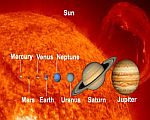- Home
- Subatomic Particles
- Lepton
Leptons - elementary parts of matter
Leptons are a group of particles that come under the blanket term of fermions, together with quarks. Like quarks, there are six different types and come in pairs, representing three generations. Each subsequent generation's pair has greater mass than the previous one.
These elementary particles are "spin 1/2" and are subject to the Pauli Exclusion Principle. Perhaps I should try and elaborate on what these things mean, before we go any further.
"Spin"
When I tell you that "spin", with regard to a subatomic particle, is a quantum attribute, you'll probably come to the depressing realisation that it won't be the same, or as straightforward, as a spinning top, a merry-go-round or a planet - things we can witness in our familiar world. No, of course, this is the quantum domain, so it's bound to be weird.
To accurately explain this attribute of fermions, which include leptons, it would require both me and you to have a pretty advanced understanding of physics, so this next bit will be greatly simplified.
Firstly, spin is an intrinsic property of a particle. Whereas a spinning object in our familiar world can be speeded up or slowed down, particle spin is constant and nothing, but nothing can change it. It also represents the intrinsic angular momentum of the particle. This is distinct from the orbital angular momentum, which is the rate at which it may be spinning. Enjoying it so far? The angular momentum is a quantum state.
If "spin" doesn't actually mean "spin" in the case of leptons, then why call it that? Well, scientists discovered that one of the most well-known leptons - the electron - possessed a magnetic field (called, rather quaintly, a "magnetic moment"). This is a characteristic of a spinning object that has an electric charge. So, they surmised it was spinning. Trouble was, to produce a magnetic field such as the strength they measured, the particle would have to be spinning faster than the speed of light - and, of course, this is not possible.
This is why the "spin" idea had to be abandoned. The phenomenon was just considered to be a property of the electron that just was. Just to make things more difficult, they still kept the expression "spin".
To try an give you some idea of what "spin 1/2" is, imagine standing on a platform that could rotate. If it turned through 360 degrees, you'd be back looking in the direction you started at, wouldn't you? That's in our familiar world. In the quantum domain, particles with spin 1/2, after being rotated similarly, would end up pointing in the other direction. I know that's crazy, but that's quantum physics for you.
The Pauli Exclusion Principle
At the end of the previous section, the electron on the rotating platform, when it ended up pointing the other way after a 360 degree turn, has changed to a different quantum state. Electrons, therefore, have two possible quantum states, known as spin up and spin down.
Pauli's Exclusion Principle states that no two identical fermions (so that's quarks as well as leptons) can occupy the same quantum state. Now, as it happens, this rule is of major importance in the creation of all the elements and resulted in the Periodic Table.
It is generally thought (even from basic school physics lessons) that atoms have a nucleus with various numbers of electrons orbiting round it. However, it is the structure of these electrons that's important. They are arranged in concentric spheres around the nucleus, the closest being the highest energy level (s1). This is where the Pauli Exclusion Principle comes into play.
Let's consider the second most simple element, helium. It has just two electrons, so, according to Pauli, they can both occupy the s1 level by being spin up and spin down - different quantum states. Now, if we proceed to the next element, lithium, this has three electrons. The third one cannot join the s1 level, as that would require it to be identical to one of the other electrons. So it occupies the next level out, s2.
This process carries on for all the elements. As the number of shells increases, other quantum attributes come into play, such as charge, momentum, energy level and mass, thus allowing more electrons per shell without violating Pauli. As the properties of elements are governed by the number of electrons in their outer shell, those with different numbers of shells, but the same number of electrons in the outer one, will display similar properties and this fact led directly to the creation of the Periodic Table.
The Pauli Exclusion Principle also explains why it is possible for matter to actually form. Without this feature of fermions, you, me and everything else we see around us wouldn't be able to exist.
The Different Types of Leptons
As stated earlier, there are six different types. We've already mentioned one - the electron - and this is a first generation lepton, along with its partner, the electron neutrino. (This latter object has been nicknamed the "ghost particle" and has its own page on this site here.) These are the only leptons that are stable and that is why there are only electrons in atoms.
The electron was discovered in 1897, while the electron neutrino, even though theorised by Wolfgang Pauli in 1930, wasn't confirmed until 1956.
The first particle in the next generation, the muon, was discovered in 1936. After the existence of the electron neutrino was confirmed, it was postulated that the muon might have a partner, too. After a few years of searching, the muon neutrino was finally discovered in 1962.
A third generation was proved to exist in the mid-1970s with the discovery of the tau. Its partner, the tau neutrino, eluded detection for a quarter of a century, until it was discovered in 2000.
In more recent years, the existence of a fourth generation of leptons has been postulated. Many scientists didn't agree with this theory, however, and with the apparent discovery of the Higgs boson, the possibility of a fourth generation has become even more unlikely, as the large mass a fourth generation would possess would involve the particles interacting with the Higgs very strongly, the resultant modification of its properties making it impossible to detect.









Facebook Comments
Have your say about what you just read! Leave me a comment in the box below.